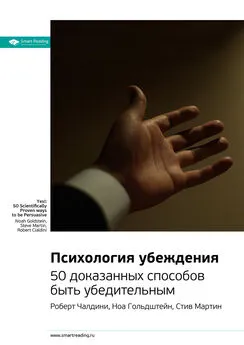Роберт Чалдини - Психология влияния. Как научиться убеждать и добиваться успеха
- Название:Психология влияния. Как научиться убеждать и добиваться успеха
- Автор:
- Жанр:
- Издательство:Питер
- Год:2014
- Город:СПб
- ISBN:978-5-496-01033-7
- Рейтинг:
- Избранное:Добавить в избранное
-
Отзывы:
-
Ваша оценка:
Роберт Чалдини - Психология влияния. Как научиться убеждать и добиваться успеха краткое содержание
«Психология влияния» — одно из лучших учебных пособий по социальной психологии, конфликтологии, менеджменту, по мнению большинства западных и отечественных психологов. Книга Роберта Чалдини выдержала в США пять изданий, ее тираж давно уже превысил два миллиона экземпляров. Эта работа, подкупающая читателя легким стилем и эффектной подачей материала, — серьезный труд, в котором на самом современном уровне анализируются механизмы мотивации, усвоения информации и принятия решений.
Новое, переработанное и дополненное, издание международного бестселлера займет достойное место в библиотеке психолога, менеджера, педагога, политика — каждого, кто по роду деятельности должен убеждать, воздействовать, оказывать влияние.
Психология влияния. Как научиться убеждать и добиваться успеха - читать онлайн бесплатно ознакомительный отрывок
Интервал:
Закладка:
Brockner, J., Rubin, J.Z. (1985). Entrapment in escalating conflicts: A social psychological analysis. New York: Springer-Verlag.
Brown, M. (2008, January 17). Montana high school cancels climate speech. MiamiHerald.com. Retrieved from http://www.miamiherald.com/news/nation/AP/story/383710.
Brown, S.L., Asher, T., Cialdini, R.B. (2005). Evidence of a positive relationship between age and preference for consistency. Journal of Research in Personality, 39, 517–533.
Brownstein, A. (2003). Biased predecision processing. Psychological Bulletin, 129 , 545–568.
Brownstein, A. Read, S.J., Simon, D. (2004). Personality and Social Psychology Bulletin, 30, 89–904.
Brownstein, R., Katzev, R. (1985). The relative effectiveness of three compliance techniques in eliciting donations to a cultural organization. Journal of Applied Social Psychology, 15 , 564–574.
Budesheim, T.L., DePaola, S.J. (1994). Beauty or the beast? The effects of appearance, personality, and issue information on evaluations of political candidates. Personality and Social Psychology Bulletin, 20, 339–348.
Burger, J.M. (in press). Replicating Milgram: Would people still obey today? American Psychologist.
Burger, J.M. & Caldwell, D.F. (2003). The effects of monetary incentives and labeling on the foot-in-the-door-effect. Basic and Applied Social Psychology, 25 , 235–241.
Burger, J.M., Petty, R.E. (1981). The low-ball compliance technique: Task or person commitment? Journal of Personality and Social Psychology, 40, 492–500.
Burger, J.M., Horita, M., Kinoshita, L., Roberts, K., Vera, C. (1997). Effects of time on the norm of reciprocity. Basic and Applied Social Psychology, 19, 91–100.
Burger, J.M., Messian, N., Patel, S., del Prado, A., Anderson, C. (2004). What a coincidence! The effects of incidental similarity on compliance. Personality and Social Psychology Bulletin, 30, 35–43.
Burgoon, M., Alvaro, E., Grandpre, J., Voulodakis, M. (2002). Revisiting the theory of psychological reactance. In J.P. Dillard and M. Pfau (Eds.), The persuasion handbook: Theory and practice (pp. 213–232). Thousand Oaks, CA: Sage.
Burn, S.W. (1991). Social psychology and the stimulation of recycling behaviors: The block leader approach. Journal of Applied Social Psychology, 21, 611–629.
Bushman, B.J. (1988). The effects of apparel on compliance. Personality and Social Psychology Bulletin, 14, 459–467.
Buss, D.M., Kenrich, D.T. (1998). Evolutionary social psychology. In D.T. Gilbert, S.T. Fiske & G. Lindzey (Eds.), The handbook of social psychology (4th ed.) (Vol. 2, pp. 982–1026). Boston: McGraw-Hill.
Carducci, B.J., Deuser, P.S., Bauer, A., Large, M., Ramaekers, M. (1989). An application of the foot-in-the-door technique to organ donation. Journal of Business and Psychology, 4, 245–249.
Castellow, W.A., Wuensch, K.L., Moore, C.H. (1990). Effects of physical attractiveness of the plaintiff and defendant in sexual harassment judgments. Journal of Social Behavior and Personality, 5 , 547–562.
Chaiken, S. (1979). Communicator physical attractiveness and persuasion. Journal of Personality and Social Psychology, 37 , 1387–1397.
Chaiken, S. (1986). Physical appearance and social influence. In C.P. Herman, M.P. Zanna & E.T. Higgins (Eds.), Physical appearance, stigma, and social behavior: The Ontario Symposium (Vol. 3, pp. 143–177). Hillsdale, NJ: Lawrence Erlbaum.
Chaiken, S., Trope, Y. (Eds.) (1999). Dual-process theories in social psychology. New York: Guilford.
Chajut, E., Algom, D. (2003). Selective attention improves under stress. Journal of Personality and Social Psychology, 85 , 231–248.
Chartrand, T.L., Bargh, J.A. (1999). The chameleon effect: The perception-behavior link and social interaction. Journal of Personality and Social Psychology, 76, 893–910.
Cialdini, R.B., Ascani, K. (1976). Test of a concession procedure for inducing verbal, behavioral, and further compliance with a request to give blood. Journal of Applied Psychology, 61, 295–300.
Cialdini, R.B., Borden, R.J., Thome, A., Walker, M.R. Freeman, S., Sloan, L.R. (1976). Basking in reflected glory: Three (football) field studies. Journal of Personality and Social Psychology, 34, 366–375.
Cialdini, R.B., Cacioppo, J.T., Bassett, R., Miller, J.A. (1978). Low-ball procedure for producing compliance: Commitment then cost. Journal of Personality and Social Psychology, 36 , 463–476.
Cialdini, R.B., Trost, M.R., Newsom, J.T. (1995). Preference for consistency: The development of a valid measure and the discovery of surprising behavioral implications. Journal of Personality and Social Psychology, 69, 318–328.
Cialdini, R.B., Vincent, J.E., Lewis, S.K., Catalan, J., Wheeler, D., Darby, B.L. (1975). Reciprocal concessions procedure for inducing compliance: The door-in-the-face technique. Journal of Personality and Social Psychology, 31, 206–215.
Cialdini, R.B., Wosinska, W., Barrett, D.W., Butner, J., Gornik-Durose, M. (1999). Compliance with a request in two cultures: The differential influence of social proof and commitment/consistency on collectivists and individualists. Personality and Social Psychology Bulletin 25 , 1242–1253.
Cioffi, D., Garner, R. (1996). On doing the decision: The effects of active versus passive choice on commitment and self-perception. Personality and Social Psychology Bulletin, 22 , 133–147.
Clark, M.S. (1984). Record keeping in two types of relationships. Journal of Personality and Social Psychology, 47 , 549–557.
Clark, M.S., Mills, J. (1979). Interpersonal attraction in exchange and communal relationships. Journal of Personality and Social Psychology, 37 , 12–24.
Clark, M.S., Waddell, B. (1985). Perceptions of exploitation in communal and exchange relationships. Journal of Personal and Social Relationships, 2 , 403–418.
Clark, M.S., Mills, J., Powell, M. (1986). Keeping track of needs in communal and exchange relationships. Journal of Personality and Social Psychology, 51, 333–338.
Clark, M.S., Mills, J.R., Corcoran, D.M. (1989). Keeping track of needs and inputs of friends and strangers. Personality and Social Psychology Bulletin, 15 , 533–542.
Clark, R.D., Ill, Word, L.E. (1972). Why don’t bystanders help? Because of ambiguity? Journal of Personality and Social Psychology, 24, 392–400.
Clark, R.D., III, Word, L.E. (1974). Where is the apathetic bystander? Situational characteristics of the emergency. Journal of Personality and Social Psychology, 29 , 279–287.
Cohen, A. (1999, May 31). Special report: Troubled kids. Time, p. 38.
Cohen, M., Davis, N. (1981). Medication errors: Causes and prevention. Philadelphia: G.F. Stickley Co.
Cook, D. (1984). Charles de Gaulle: A biography. New York: Putnam.
Craig, K.D., Prkachin, K.M. (1978). Social modeling influences on sensory decision theory and psychophysiological indexes of pain. Journal of Personality and Social Psychology, 36, 805–815.
Cronley, M., Posavac, S.S., Meyer, T., Kardes, F.R., Kellaris, J.J. (2005). A selective hypothesis testing perspective on price-quality inference and inference-based choice. Journal of Consumer Psychology, 15 , 159–169.
Dai, X., Wertenbroch, K., Brendel, C.M. (2008). The value heuristic in judgments of relative frequency. Psychological Science, 19, 18–19.
Darley, J.M., Latane, B. (1968). Bystander intervention in emergencies: Diffusion of responsibility. Journal of Personality and Social Psychology, 8, 377–383.
Dauten, D. (2004, July) How to be a good waiter and other innovative ideas. Arizona Republic, p. D3.
Davidson, P. (1999, June 16). Gates speaks softly of antitrust laws. USA Today, p. B2.
Davies, J.C. (1962). Toward a theory of revolution. American Sociological Review, 27 , 5–19.
Davies, J.C. (1969). The J-curve of rising and declining satisfactions as a cause of some great revolutions and a contained rebellion. In H.D. Graham &T.R. Gurr (Eds.), Violence in America. New York: Signet Books.
De Paulo, B.M., Nadler, A., Fisher, J.D. (Eds.). (1983). New directions in helping: Vol. 2, Help seeking. New York: Academic Press.
Deci, E.L., Ryan, R.M. (1985). Intrinsic motivation and self-determination in human behavior. New York: Plenum.
DeDreu, C.K. W, McCusker, C. (1997). Gain-loss frames and cooperation in two-person social dilemmas: A transformational analysis. Journal of Personality and Social Psychology, 72 , 1093–1106.
Deutsch, M., Gerard, H.B. (1955). A study of normative and informational social influences upon individual judgment. Journal of Abnormal and Social Psychology, 51 , 629–636.
Dhami, M.K. (2003). Psychological models of professional decision making. Psychological Science, 14, 175–180.
Dion, K.K. (1972). Physical attractiveness and evaluation of children’s transgressions. Journal of Personality and Social Psychology, 24, 207–213.
Dixon, J., Durrheim, K., Tredoux, C. (2005). Beyond the optimal contact strategy: A reality check for the contact hypothesis. American Psychologist, 60, 697–711.
Doob, A.N., Gross, A.E. (1968). Status of frustrator as an inhibitor of horn-honking response. Journal of Social Psychology, 76 , 213–218.
Downs, A. C, Lyons, P.M. (1990). Natural observations of the links between attractiveness and initial legal judgments. Personality and Social Psychology Bulletin, 17, 541–547.
Drachman, D., deCarufel, A., Inkso, C.A. (1978). The extra credit effect in interpersonal attraction. Journal of Experimental Social Psychology, 14, 458–467.
Driscoll, R., Davis, K.E., Lipetz, M.E. (1972). Parental interference and romantic love: The Romeo and Juliet effect. Journal of Personality and Social Psychology, 24 , 1–10.
Eagly, A.H., Wood, W., Chaiken, S. (1978). Causal inferences about communicators and their effect on opinion change. Journal of Personality and Social Psychology, 36, 424–435.
Easterbrook, J.A. (1959). The effects of emotion on cue utilization and the organization of behavior. Psychological Review, 66, 183–201.
Efran, M.G., Patterson, E.W. J. (1976). The politics of appearance. Unpublished manuscript, University of Toronto.
Eibl-Eibesfeldt, I. (1975). Ethology: The biology of behavior (2d ed.). New York: Holt, Rinehart &Winston.
Emswiller, T., Deaux, K., Willits, J.E. (1971). Similarity, sex, and requests for small favors. Journal of Applied Social Psychology, 1, 284–291.
Epley, N., Gilovich, T. (2006). The anchoring-and-adjustment heuristic: Why adjustments are insufficient. Psychological Science, 17 , 311–318.
Eron, L.D., Huesmann, L.R. (1985). The role of television in the development of prosocial and antisocial behavior. In D. Olweus, M. Radke-Yarrow &J. Block (Eds.), Development of prosocial and antisocial behavior. Orlando, FL: Academic Press.
Evans, F.B. (1963). American Behavioral Scientists, 6 (7) , 76–79.
Facci, E., L, Kasarda, J.D. (2004). Revisiting wind-shear accidents: The social proof factor. Proceedings of the 49th Corporate Aviation Safety Seminar (pp. 205–232). Alexandrea, VA: Flight Safety Foundation, Inc.
Fang, X., Singh, S., Ahulwailia, R. (2007). An examination of different explanations for the mere exposure effect. Journal of Consumer Research, 34, 97–103.
Читать дальшеИнтервал:
Закладка:










